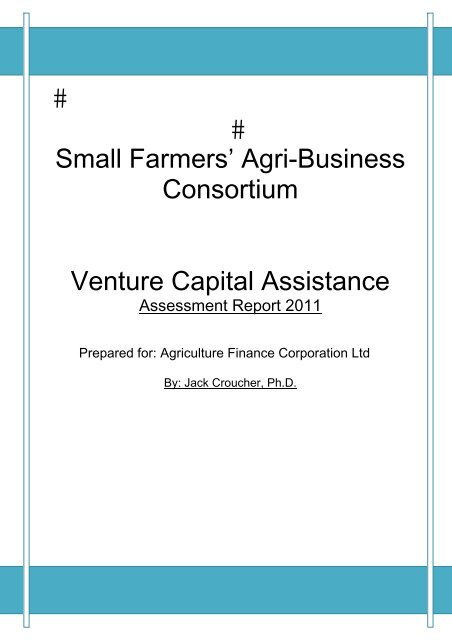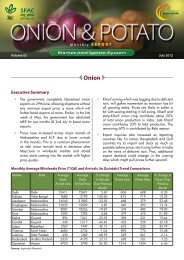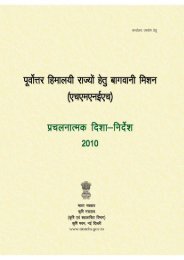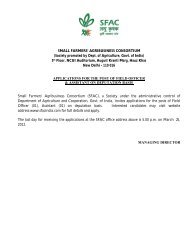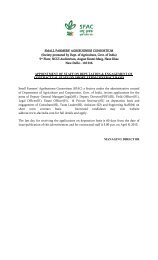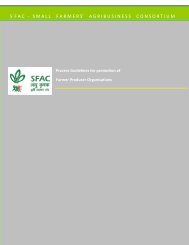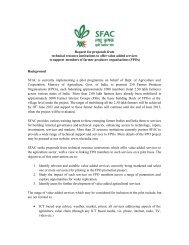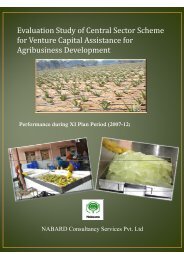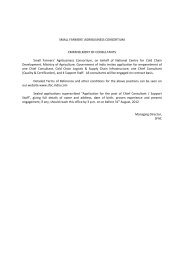Qualitative Assessment - 2011 - SFAC
Qualitative Assessment - 2011 - SFAC
Qualitative Assessment - 2011 - SFAC
You also want an ePaper? Increase the reach of your titles
YUMPU automatically turns print PDFs into web optimized ePapers that Google loves.
CONTENTS <strong>SFAC</strong> VCAASSESSMENT REPORTPageGlossary of Terms 4-5I. Introduction 6-121.1 Purpose and Scope of <strong>Assessment</strong>1.2 Approach, Methodology and Report StructureII. Background 12-132.1 <strong>SFAC</strong> Programme2.2 The Current <strong>SFAC</strong> - VCA Intervention LogicIII. Performance and Results 13-16 15-173.1 Relevance3.2 Effectiveness3.3 Efficiency3.4 Sustainability3.5 ImpactIV. The Revised Intervention Logic 16-184.1 Rural Development focus: Farmer Linkages4.2 Rural Development focus: Agri-Business Development4.3 Rural Development focus: Livelihoods4.4 Rural Development focus: Convergence4.5 International Competitiveness Focus: Farmer Linkages4.6 International Competitiveness Focus: Agri-Business Development4.7 International Competitiveness Focus: LivelihoodsV. Project Cycle Management 19-205.1 Identification and Formulation of Interventions5.2 Design2
5.3 Implementation5.4 Management and BackstoppingVI. A Forward Looking Perspective 20-246.1 Contextual Background6.2 A Future <strong>SFAC</strong> Intervention Typology6.3 Design and Implementation6.3 Organization and FinancingVII. Conclusions and Recommendations 24-257.1 Summary of FindingsVIII. Lessons Learned 25-26Annex AAnnex BAnnex CAnnex DAnnex EAnnex FAnnex G: Report of Findings from North East <strong>Assessment</strong>, D.V. Nityanand, AFC: List of Persons Contacted: Terms of Reference: List of Review Sample: Standardized Framework for Assessing Company-Farmer LinkageProgramme: Company-Farmer Linkage Questionnaire Form: Individual Company Questionnaires3
GLOSSARY OF TERMSTermBaselineEffectEffectivenessEfficiencyImpactsIndicatorInterventionLessons LearnedDefinitionThe situation, prior to an intervention, against which progress can beassuredIntended or unintended change due directly or indirectly to aninterventionThe extent to which the development intervention’s objectives wereachieved, or are expected to be achieved.A measure of how economically resources/inputs (funds, expertise,time, etc.) are converted to resultsPositive and negative, primary and secondary long-term effectsproduced by a development intervention, directly or indirectly, Intendedor unintendedQuantitative or qualitative factor or variable that provides a simple andreliable means to measure achievement, to reflect the changesconnected to an intervention, or to help assess the performance of adevelopment actorAn external action to assist a national effort to achieve specificdevelopment goalsGeneralizations based on evaluation experiences with projects,programs, or policies that abstract from the specific circumstances tobroader situations. Frequently, lessons highlight strengths orweaknesses in preparation, design, and implementation that affectperformance, outcome, and impactLog frame (Logical frame work)Management tool used to improve the design of interventions, mostoften at the project level. It involves identifying strategic elements5
(inputs, outputs, outcomes, impact) and their causal relationships,indicators, and the assumptions or risks that may influence success andfailure. It thus facilitates planning, execution and evaluation of adevelopment intervention. Related term: results based managementOutcomeOutputSustainabilityThe likely or achieved short-term and medium-term effects of anIntervention’s outputs. Related terms: result, outputs, impacts, effect.The products, capital goods and services which result from adevelopment intervention; may also include changes resulting from theintervention which are relevant to the achievement of outcomesThe continuation of benefits from a development intervention aftermajor development assistance has been completed. The probability ofcontinued long-term benefits. The resilience to risk of the net benefitflows over time.6
I. INTRODUCTION1.1 PURPOSE AND SCOPE OF ASSESSMENTThe nature of this assessment is forward looking. By examining a sample of typical <strong>SFAC</strong>VCA interventions, both successful and unsuccessful, the purpose is to learn fromexperiences of the past in order to design a revised intervention strategy for theorganization. The goal is to contribute towards the ongoing strategic planning <strong>SFAC</strong> isundertaking to continue and enhance its relevance as an important resource in agribusinessin India in an ever evolving global economy.Throughout the assessment answers were sought to a number of questions. This wasdone through face to face interactions with entrepreneurs, farmers, bankers and others ina systematic manner. The methodology is described below. But the essence of thesequestions are summed up here in the introduction:1. Awareness level among entrepreneurs about <strong>SFAC</strong>All the entrepreneurs had a basic knowledge of <strong>SFAC</strong> due primarily to being recipients ofthe VCA and in some cases its Project Development Facility. This basic understanding islimited to the conditions of the VCA, primarily that it has a grace period of five years, mustbe paid back in full, and only the original amount dispersed is required to be returned.Although <strong>SFAC</strong> conditions also require an earlier return if the term loan is paid off, most ifnot all understand it to be a five-year grace period.Some of the recipients of the VCA seemed unaware of the Project Development Facilityand expressed the view that they could have made use of it.A few entrepreneurs had some contact with <strong>SFAC</strong> staff either from the headquarters orfrom the state level staff seconded to <strong>SFAC</strong>. These had a greater awareness of <strong>SFAC</strong> inthe sense that they not only recognized the value of the VCA but were keen to availthemselves of a second round should that become available7
It is clear that where <strong>SFAC</strong> has a solid presence on the ground, as is the case of theregional office in the Northeast, that awareness of <strong>SFAC</strong> is greatest. In the other statesvisited, the departments responsible for <strong>SFAC</strong> have a spotty record. The state <strong>SFAC</strong>officer in Kerala seemed very engaged, but that could have been due to the presence of asenior staff person from headquarters; in Kashmir, the consultant seemed minimallyinterested and in Maharashtra there was no response at all.It is not clear, with the exception of the regional staff located in Guwahati, how much local<strong>SFAC</strong> representatives actually represent <strong>SFAC</strong> and its interests. As far ascommunications with the headquarters it generally seems to be minimal after the VCA isawarded. While there was no clear indication from the recipients, the lack ofcommunication could lead to their taking the pay-back requirement less seriously then theyshould.2. Entrepreneurs experience with banks and <strong>SFAC</strong> including past disbursements andoperational problems.Experience with the banks was mixed. The entrepreneurs in Kashmir seem most satisfiedwith their experience with the lending institutions; the experience in the Northeast regionwas most problematic. Maharashtra and Kerala fall somewhere in between satisfactoryand problematic depending on the case in question. In almost all cases the length of timebetween initiating an application to actual disbursement was seen as unnecessarily longand the access to working capital remains a major constraint to the success of manyventures.There are a number of problems associated with the lending institutions’ functioning in the<strong>SFAC</strong> projects assessed in the sample which are summarized below:A) In most venture capital investments the venture capitalist and the entrepreneurjointly prepare a project feasibility proposal that they then jointly present to a bankfor financing of both fixed and working capital. In <strong>SFAC</strong> procedures it seems thatthe entrepreneur initially arranges for a feasibility assessment prepared along8
traditional lines which he presents to a bank. If the bank agrees to a term loanthen <strong>SFAC</strong> is approached for its VCA participation.This latter approach leads to a number of weaknesses in the process.Project Appraisal: To begin with a project’s feasibility is appraised primarilyon its financial and technical merits. Other essential criteria including a clearunderstanding of end markets, of the complete value chain and its degree ofcompetitiveness and future growth potential, the scope and type of farmerlinkages, and the potential for off-farm employment generation are not givenmuch consideration. Technical feasibility is seldom a problem for smallenterprises these days in India and while it is essential that it be included inall project appraisals, a project is rarely rejected on technical grounds.Financial viability, while is also an important criteria, is seldom found to be areason for rejecting a project. (Any project can be made to look profitable in abusiness plan given the right set of assumptions). Therefore, in addition tofinancial and technical viability, potential projects need to be assessed on thenature of the value chain in which they are to function, on the clarity ofunderstanding end markets and the competition they will face in thosemarkets, on the enterprise’s ability to adapt to changes in the value chainincluding its ability to upgrade to keep pace with an ever evolving economyand on the scope, transparency and nature of farmer linkages.Access to capital: Working capital: In almost all sample enterprises, accessto working capital is a major constraint. In many cases working capital is noteven purposely considered in the financial planning or calculations. Thispractice appears illogical on the part of the lending institutions. In case aftercase when the entrepreneur approached the lending institutions for workingcapital, he was either denied, or was approved for an amount far less thanrequired, or was faced with substantial delays in taking a decision or indisbursements. In some cases when working capital was approved, thelending institution then applied a portion of the sanctioned working capital9
loan against the interest of the term loan again leaving the entrepreneur withinsufficient resources with which to operate successfully. This approach toproviding working capital has resulted in enterprises running far belowinstalled capacity, lengthening the time to reach a break-even point, greatlyreducing revenues and ultimately threatening the viability of the business andhence its ability to repay both the term loan and the VCA.Interest rates: in most term loans the interest rate is set at the going rate forconventional business lending. There is reason to argue that since thesebusinesses are directly part of the agriculture sector and are the next logicalstep in the agriculture value chain, that term lending and working capitallending should be given priority sector status and interest rates accordinglyadjustedB) Ministry of Food Processing Subsidy. Most enterprises were eligible for and didreceive this subsidy after the qualification criteria were met. In some cases, thelending institution appropriated this subsidy and applied it toward the term loanprincipal, without the entrepreneur’s consent. If lending institutions are to insist onappropriateing this subsidy for themselves, such should be stated upfront in theterm loan agreement and the interest rate should be adjusted to reflect thereduced risk and exposure of the bank. This practice leads to the impression thatthe banks are more concerned with reducing their exposure and risk than incontributing to the success of the enterprise that they have already assessed as aviable investment. It also needs to be ascertained whether the Ministry of FoodProcessing is aware that this subsidy that is meant for the agri-businessentrepreneur is actually being used to subsidize the lending institution’s exposure.Ideally this practice should be discouraged.C) In only one case was there a complaint voiced about <strong>SFAC</strong>. It had to do with theamount of VCA sanctioned being greater than the amount actually dispersed. The10
complaint had more to do with the entrepreneur’s opinion that the explanationgiven by <strong>SFAC</strong> was not satisfactory.In one other case, <strong>SFAC</strong> VCA was being held back by the loan officer of aparticular bank (along with the sanctioned term loan) without explanation. <strong>SFAC</strong>’sresponse to this situation - sending a letter requesting release of the VCA fundsdoes not seem to have the desired effect. Perhaps a more proactive stance isneeded.3. Experiences with local authoritiesThere has been little convergence among <strong>SFAC</strong> VCA participants with other governmentor non-government programs that might be beneficial to the companies. Particularly in theNortheast there are many programs specifically designed to promote agriculturedevelopment. Organic certification of many products has good potential particularly in theNortheast, where cultivation is by and large de facto organic. Also, The Spice Board hasseveral programs for Northeast that could benefit those enterprises engaged in spiceproduction and processing. Clean Energy Assistance Schemes are another that could beavailed. Also of great relevance to small enterprises is the Interest on Delayed Paymentsto Small Scale and Ancillary Industries Act, 1993.These are just four illustrative examples. There are numerous government programs anddonor funded projects that could be tapped by small enterprises if their existence wereknown. The one good example from the sample undertakings is Kerala Aqua Ventureswhich has made very profitable use of state government programs and assistance.4. Relationship of units to markets:While access to markets is never easy, in the sample cases it does not seem to present amajor problem. This can be attributed to the tenacity of the entrepreneurs and their abilityto select subsectors that have growth potential. As these enterprises grow they will needassistance in finding new markets and in access to market intelligence. Of the twelveactive investments, seven are able to access both domestic and international markets;11
while three are selling mainly to national markets and two are limited to local or regionalmarkets.Access to markets is one issue but the ability to compete in those markets is another. It ishere where the weakness of the initial feasibility assessment comes into play. Lack ofguidance leads some commercial undertakings to choose markets in which their ability tocompete is questionable. This is particularly true for small-scale units attempting toestablish their own brand name. This will be an uphill battle that they are unlikely to win inthe face of competition from major companies with well- established brands. This isparticularly characteristic of the processed foods market where consumers are more likelyto purchase a well-known brand name product.5. Path forward after VCA stage:A few enterprises have exited the VCA stage or are about to exit and they are well placedto succeed at their current levels of operation. However, if they wish to grow they may facedifficulties accessing the needed financial and non-financial business services. Muchdepends on the size of the enterprise, which in turn is positively correlated to thepromoter’s level of sophistication and ability to work the system to his advantage. Inaddition to concern about a post VCA path forward, of greater concern is assisting existingenterprises to reach the post VCA stage.In both situations there is currently no facility available to assist small entrepreneurs indealing with the myriad of problems and issues that they face on almost daily. While theentrepreneurs in the sample assessment represent the tenacity of Indian entrepreneurs ingeneral, continued success in the global economy will require more than tenacity alone.6. Farmers’ views:By and large the farmers who were interviewed are very satisfied with their relations withthe linked companies and the benefits they were enjoying. In every case the farmers firstand foremost appreciated the security that linkage gave them in terms of assured markets,assured prices, assured transparency in all transactions. The degree and nature of other12
services provided to the linked farmers by the companies varied greatly from no additionalservices at all to extensive interaction in the form of providing inputs, credit, advances, andextension assistance. In all case both farmers and company promoters and othersinterviewed including banking officers and government officlas strongly supported the needfor some form of organization of farmers, either formal or informal. All see this as a win-wininnovation benefitting both the farmers and the companies.1.2 APPROACH AND METHODOLOGYThe assessment was managed by the Agriculture Finance Corporation Ltd. (AFC) andcarried out by one consultant and by one senior officer from AFC. <strong>SFAC</strong>/AFC providedadditional support as needed. The assessment encompassed the following steps:1. Desk review, <strong>SFAC</strong> staff interviews and analysis:A desk review will be carried out in order to select targeted enterprises for assessment; togather information on the performance and results to date of selected enterprises; on<strong>SFAC</strong>’s perceptions of the strengths and weaknesses of investment design,implementation and management. This step will include:systematic review and analysis of previous <strong>SFAC</strong> evaluation reportsreview of <strong>SFAC</strong> investment documentation on selected enterprises such as projectreports, completion reports, progress reports, technical reports.Discussion with relevant <strong>SFAC</strong> staff at headquarters on assessment issues andpossible ways forwardBased on the above key assessment issues the assessment consultant and AFCstaff associate will develop a standardized framework for assessing each selectedenterprise in order to ensure consistency when reviewing projects and to extractcomparable information. The assessment framework will employ aspect of valuechain analysis and will be consistent with <strong>SFAC</strong>’s investment logic.13
2. Development of <strong>SFAC</strong> Agribusiness Investment logic(s) 1Based on the steps described above, the assessment consultant will construct theinvestment logics (premises of change expected by <strong>SFAC</strong> interventions) of typical <strong>SFAC</strong>support interventions. These premises will map out how inputs and activities should havelogically led to outputs, outcomes, and impacts. This will enable the assessment toconduct analysis along the causal chain from inputs (equity and loans and perhaps otherdevelopment services) to impacts, to build the story around these interventions and todetermine if these interventions have worked as planned.The investment logics will be validated through discussions with the <strong>SFAC</strong> staff members.This consultation between the consultant and <strong>SFAC</strong> will be useful for <strong>SFAC</strong> to validate itsown strategy and make necessary changes to keep pace with an evolving rural economy.3. ReportingThe main deliverable of the assessment exercise is the final report in English. The reportwill cover the key assessment issues outlined above in section I. It will describe themethodology used and highlight any methodological limitations, highlight key concerns andpresent evidence–based findings, conclusions, recommendations and lessons learned.The draft report focusing on lessons learned, best practices, and recommendations will beshared with <strong>SFAC</strong> staff for initial review and consultation. They may provide feedback onany error or fact and may highlight the significance of such errors that find their way intoconclusions. The consultant will seek agreement on the findings and recommendationsand will take comments into consideration when preparing the final report, but theconsultant will be independent to draw his own conclusions and recommendations.1 <strong>SFAC</strong> investment logic: promotion of agribusiness ventures in cooperation with commercialbanks; catalyzing private investment in establishing/expanding agribusiness projects;strengthening backward linkages with primary producers; generation of rural employmentopportunities; and, enhanced participation in value chains for farmers, producer groups, smallscaleentrepreneurs, and agriculture graduates.14
Field Interviews:The assessment was undertaken on a sample of 15 companies that had received venturecapital assistance from <strong>SFAC</strong>. These 15 units varied in a number of ways: some weremature and had either graduated out of the VCA programme or were close to leaving;some were very recent recipients; most were successful operating businesses while a fewwere listed as non-performing assets; they were located in four distinct parts of thecountry: The Northeast, Kashmir, Kerala, and Maharashtra. The one thing all had incommon was their backward linkage to farmers.A questionnaire was developed and systematically applied to all the available units. This isfound in Annex F. The individual questionnaires are found in Annex G. The main focuswas on the nature and substance of backward linkages to farmers and the entrepreneurs’experiences with the lending institutions.15
II. BACKGROUND2.1 <strong>SFAC</strong> PROGRAMMESmall Farmers’ Agri-Business Consortium (<strong>SFAC</strong>) is a society organized under theDepartment of Agriculture and Cooperation of The Government of India with a mandate tocatalyze private investment in setting up agri-business undertakings that will enhance ruralincomes and generate both farm and off-farm employment. It has been in operation since1994 and currently has over three-hundred active investments.The primary vehicles used by <strong>SFAC</strong> are its Venture Capital Assistance to agri-businessundertakings (VCA) and its Project Development Facility (PDF) to assist producergroups/organizations in the preparation of economically viable detailed project proposals.In close association with commercial banks the scheme envisages a single-windowapproach for extending venture capital along with term loans and working capital to agribusinessapplicants.Qualifying projects should meet the following criteria:a) Should be in the agriculture or allied sector (i.e. horticulture, floriculture, medicinaland aromatic plants, minor forest products, sericulture, organic farming, vermicomposting,apiculture, plantation crops and fisheries.b) Should provide assured market to farmers/producer groupsc) Should encourage diversification into high value crops to increase farm householdincome. Andd) Should qualify for term lending by participating banks.2.2 THE CURRENT <strong>SFAC</strong>-VCA INTERVENTION LOGICa) To facilitate setting up agri-business ventures in close association with commercial16
anksb) To catalyze private investment in establishing agri-business projects and therebyproviding assured market for producers for increasing rural income andemployment.c) To strengthen backward linkages of agri-business undertakings with primaryproducersd) To assist farmers, producer groups, and agriculture graduates to enhance theirparticipation in the value chain through the Project Development Facility. Ande) To arrange training and exposure visits of agripreneurs interested in setting upidentified agri-business projects.17
III. PERFORMANCE AND RESULTSOf the 15 companies in the assessment sample, three are considered genuine nonperformingassets (NPAs). Twelve are operational to varying degrees.3.1 RELEVANCERelevance means that the VCA investment is appropriate for achieving the objectives inaccordance with the needs and priorities of the target groups (the promoters of thecommercial ventures and the farmers linked to those ventures) and is aligned with theobjectives of <strong>SFAC</strong> and its VCA programme.Relevance is assessed as relatively high in most of the operational companies. Theinterventions are well aligned with the objectives of <strong>SFAC</strong> and its VCA programme; theventure capital infusion has generated participation of financial institutions, although not tothe extent desirable; has generated investment by the promoters; and has created genuinebackward linkages to farmers. In many cases the businesses sampled would not havebeen able to secure term financing with out <strong>SFAC</strong> VCA.3.2 EFFECTIVENESSEffectiveness is the extent to which the intervention’s objectives were achieved, or areexpected to be achieved.Effectiveness is mixed. In some cases where the promoters have considerable experienceand resources, the interventions have been quite effective. A case in point would beTrimurti Corns. It initially proposed backward linkages with 168 farmers and seven yearslater has linkages with over 2000 farmers. Its annual turnover last year was several croreand it employs over 250 off-farm workers most of whom are women from the surroundingvillages. It markets fresh baby corn and frozen corn nibblets to markets throughout theworld.At the other end of the spectrum would be Madhu’s Foods, which has yet to receive itssanctioned term loan and its sanctioned venture capital assistance for no valid reason.18
But size is not the only measure of effectiveness. Pragati Agro in Maharashtra has only 39linked farmers, but significantly all 39 are shareholders in the private limited company – inother words, it was formed by the cultivators as a producer company before the ProducerCompany Act came into effect.It is primarily theworking capital problem noted above that is having serious consequenceson the effectiveness of the VCA programme. Thus it would have to be rated as average orbelow average in terms of effectiveness.3.3 EFFICIENCYA measure of how economically resources/inputs (funds, expertise, time, etc.) areconverted to results. Being a qualitative assessment, this study was not able to undertakean assessment of efficiency as defined above.3.4 SUSTAINABILITYSustainability is understood as the continuation of benefits from the VCA intervention afterassistance has been completed. The probability of continued long-term benefits. Theresilience to risk of the net benefit flows over time.There is no clear trend in the sample toward sustainability. The absence of serviceproviders for both financial and non-financial business development services results inthose entrepreneurs who are surviving by tenacity alone to face an uncertain future.Small-scale units such as Rity Food and Madhu’s Food which are trying to establish theirown brands in a highly competitive processed food market could make good use ofprofessional assistance in determining where their best end-market options lie.Another determinant of sustainability if the knowledge and resources to upgrade in agrowing subsector. Upgrading can involve products, processes, outsourcing and/ordiversification into other subsectors. A good example of the ability to upgrade is UplandFloritech. It not only operates in a growing and vibrant cut flowers value chain with strongend market presence, it has also upgraded in two ways: by diversifying into the high value19
fruits value chain and by introducing state of the art technologies backed-up with goodtechnical assistance.When considering sustainability for small agri-businesses, a missing component is theprovider/facilitator of financial and non-financial business services both during and afterthe project assistance is completed. Where do these entrepreneurs go for such guidance?3.5: IMPACTImpact can be positive and negative having primary and secondary long-term effectsproduced by interventions, directly or indirectly, intended or unintended.Impacts in the sense of clear contributions to enhanced economic security are difficult tocatch. There is often a long cause-effect chain from the intervention inputs and activities tothis goal. Log Frame Analysis results termed as outputs and/or outcomes can give someindications of the direction in which impacts are moving. In cases where relevance,effectiveness and sustainability are all determined to be low for the same intervention,there is most likely little doubt that impact will be small.There are two indications that imply that impacts in the overall sample will be positive andcould be significant. One is the satisfaction expressed by virtually every farmer and everyentrepreneur interviewed with the backward linkage arrangements. From the farmers’perspective this primarily has to do with the guaranteed market for produce at agreed uponprices and, as importantly, on the transparency with which the businesses conduct theirprocurement from the farmers. In most cases the only other option is dealing withtraditional brokers or mandis. Institutions that have yet to come to the realization thatshort-changing farmers is not going to be viable option for much longer.The second indication of positive impacts is the significant number of off-farm jobsgenerated by these investments. In the sample of 12 operational companies these numberin the thousands. More importantly, most of these jobs are filled by women and in manycases are sensitive to the working needs of women both in terms of working conditionsand time availability.20
In this age when accountability in development activities has become the most importantissue, it is definitely in the interest of <strong>SFAC</strong> to implement a solid monitoring and evaluationsystem that will capture these impacts in a more systematic and convincing manner.21
IV. A REVISED INTERVENTION LOGICThe current intervention logic (described on page 11, footnote 1) has been by and largesuccessful albeit with some notable weaknesses. Backward linkages to farmers arepresent and satisfactory ranging from 25 in Kairali Coconut Oil to over 2000 in TrimurtiCorns. Off-farm employment, especially for women, may be the untold success story withthe creation of thousands of employment opportunities through just a handful ofenterprises.But along with these successes there are outstanding shortcomings that can be addressedthrough a revised intervention logic.The current role of banks needs to be thoroughly reassessed: Working capital problems persist both in availability, timeliness, and sufficiency. The current threshold of Rs 50 lakhs total project cost is far to high to interest smallentrepreneurs and producer groups wanting to commercialize their operations Of the 29 million small-scale units in India, employing 90% of the work force,producing over 6000 products, receive only 10% of all bank loans Inexplicable delays in disbursement still exist in some places Lack of follow-up after a loan of disbursement unless payments are overdue Overly focused on technical and financial details with too little attention to otherinvestment criteria Little attention to forward and backward linkages Minimal end market analysis Shallow knowledge of the economic vibrancy of the sectorAll of these raise questions as to the effectiveness of the current <strong>SFAC</strong> investment logic inan ever-evolving global economy.A FUTURE <strong>SFAC</strong> INVESTMENT TYPOLOGY:A revised typology takes note of the changing global economy as it relates to agribusinessin India. Beyond considering the financial requirements of a business, it focuses22
from both a domestic and an international perspective on farmer linkages both backwardand forward, on agri-business development, on rural livelihoods and on convergence.4.1RURAL DEVELOPMENT FOCUS – FARMER LINKAGES :Interventions both organizational and technological are required that lead to greaterintegration of producers into value chains that serve domestic markets – local, regionaland national and that lead to greater economic security of producers in a sustainablemanner. Farmer linkage models may take many forms, but past experience has proventwo necessary conditions for sustaining whatever form is chosen: associations, particularlyat the farm level, should as much as possible be self-selective; and secondly they shouldbe of a manageable size. Numbers of small, self-selected groups can be federated intolarger entities to achieve economies of scale and to increase power in businessrelationships. Of major concern is whether such interventions include small-holder farmers,or rather marginalize them in relation to general agricultural development trends. (There issome evidence that emerging corporate agribusiness strategies are beginning to focus onlinkages with larger farmers). If <strong>SFAC</strong> intends to expand its impacts and services tofarmers groups and /or small entrepreneurs it needs to address two issues. First it needsto use its Project Development Facility in a more proactive manner to scout out newerclients and to assist them in preparing convincing project applications. Secondly itcertainly needs to lower its project cost threshold from the current Rs 50 lakhs to Rs 5-10lakhs range.4.2 RURAL DEVELOPMENT FOCUS – ARGI-BUSINESS DEVELOPMENT:A value chain analysis must examine the entire chain but with a focus on interventions thati. upgrade domestic agribusiness value chains and ii. strengthen wider rural economicdevelopment impacts through the spread effects of investments and employment in otherrural-based activities. The impact of investments in agri-business on the wider economyneeds to be better understood and a value chain analysis is one good tool that can beused to get a generate a better understanding on such impacts as well as identifycomponents in the value chain that can benefit most from upgrading. Addressing food23
insecurity would seem to be more promising by focusing on domestic value chains.Domestic value chain upgrading in certain agri-business sectors would appear a naturalfor <strong>SFAC</strong> interventions. However, gains can also be made from global food value chaininterventions by analyzing the whole value chain, including agricultural raw materialproduction aspects, by more attention to post-harvest loss activities (technologies andinstitutional aspects) and by building synergies among all three subsector levels – micro-,meso- and macro-levels of the chain.4.3 RURAL DEVELOPMENT FOCUS - LIVELIHOODS:Non-farm employment generation is a significant achievement of <strong>SFAC</strong> interventions. Thisachievement needs to be better recognized and understood more deeply, particularly frompoverty alleviation and gender perspectives. <strong>SFAC</strong> needs to become more relevant agribusinessforce in those 29 million small scale units that are employing 90% of the workforce that relate to agriculture.4.4 RURAL DEVELOPMENT FOCUS - CONVERGENCE:Beyond Ministry of Food Processing subsidies, there is a need for a mechanism to identifyand publicize other forms of assistance available to small enterprises and producers thatcan contribute toward the survival and success of the enterprise. The larger, moreexperienced businessmen know how to work the system to their advantage, but thesmaller, new entrants often do not. A study conducted in Uttarakhand discovered 936schemes operating in one block. While not all of these relate to small agri-businessdevelopment, most likely some of them do, but are unknown to both the farmers, businesspromoters, and other interested parties. <strong>SFAC</strong> needs to assist small agri-business tobecome more competitive in the Darwinian environment in which they exist by takinggreater advantage of the wealth of other resources that are available to them.4.5 INTERNATIONAL COMPETITIVENESS FOCUS – FARMER LINKAGESInterventions that result both in organizational and technological improvements at theproducer level need to reflect the international competitive nature of many agribusinessenterprises. Upgrading primary producers to more value adding activities beyond24
supplying raw materials will also require a fresh look at what technologies andorganizational options are appropriate given the growing international nature of Indianagribusinesses.4.6 INTERNATIONALCOMPETITIVENES AGRI-BUSINESS DEVELOPMENT:A value chain analysis can identify interventions that are intended to ensure that theproductive capacity of an agri-business subsector has a standard that makes the industryable to export products that meet international standards and at the same time are able tocompete with imports of same or similar products in the national market. Need torecognize that within the industry, cooperation, not competition, will improve competitiveadvantage. The competition is not the company down the road or in the next town, it is inChina, Sri Lanka, Bangladesh, Thailand, Indonesia and The Philippines. The majority ofbusinesses examined in the sample, even those of modest size, had significant sales ininternational markets. Again value chain analysis can identify such opportunities.4.7 INTERNATIONAL COMPETITIVENESS - LIVELIHOODS:Recognizing that non-farm employment is processing goods that may need to compete ininternational markets. This may require preparation for a different set of skills,technologies, and work environments if Indian agri-businesses are to continue to becomeinternationally competitive.25
V. PROJECT CYCLE MANAGEMENT5.1 IDENTIFICATION AND FORMULATION OF INTERVENTIONSIn order to broaden its reach and make its services more accessible to larger numbers ofclients, especially smaller entrepreneurs and farmer groups who wish to move from beingsimple suppliers of raw materials or subsistence players to take on a more commercial role<strong>SFAC</strong> needs to make a number of adjustments: Lowering the project cost threshold to Rs 5-10 lakhs Expanding the Project Development Facility, making it more proactive and using itas a tool to scout out new clients. Expanding its partnership beyond commercial banks to other institutions that areready to supply term and working capital and are also prepared to provides otherneeded business development services of a non-financial nature <strong>SFAC</strong> needs to join with clients in taking the lead in project preparation andfeasibility assessments that include a broader array of criteria in addition totechnical and financial viability Continued support to existing projects. Reasons for continued support to existingprojects can vary, from building on to something that has already proven successful(Upland Flori Tech in Kashmir diversifying to high value fruit cultivation and usingstate of the art technology) to correcting problems (Rity Foods in Meghalaya) orensuring sustainability of less well-functioning activities that have good promise(Pragati Agro in Maharashtra). In any case the experience gained from the firstphase of the programme should be the point of departure for formulating a secondphase. These obvious opportunities are not currently being exploited.5.2 DESIGN A project design must include a workable plan for constant monitoring andevaluation of investments Must include convergence with as many other resources as possible Must view its mission as promoting the long-term success of its clients Must realize that effort put in at this stage will be more cost effective than trouble26
shooting at a later stage due to weak project designThe Project Development Facility can play a far greater role in these areas.5.3 IMPLEMENTATION <strong>SFAC</strong> needs far more dedicated personnel on the ground. This does notnecessarily mean raising a large bureaucracy. Outsourcing to competentorganizations and agencies is one option that should be looked into. <strong>SFAC</strong> needs to keep in frequent contact with its clients, particularly the smaller andnewer ones, that may need additional handholding and trouble shooting5.4 MANAGEMENT AND BACKSTOPPING At headquarters <strong>SFAC</strong> will definitely need more staff both professional and supportand a reorganization of staff if it is to achieve its new objectives.5.5 INNOVATION AND PILOT TESTING There are many innovative ideas and models both in India and abroad that haverelevance to the promotion of agri-business in the global economy. <strong>SFAC</strong> should seriously consider creating a small, flexible unit that is dedicated toidentifying and pilot testing new ideas and organizational and investment models.Those that are found to have merit could then be expanded by <strong>SFAC</strong> or otherresponsible agencies.27
VI. A FORWARD LOOKING PERSPECTIVE6.1 CONTEXTUAL BACKGROUNDGlobal inequalities and resulting in a deepening of world poverty has in recent yearsincreased rather than decreased due largely to the general global financial and economiccrisis as well as the food crisis most prominently felt by rising food prices even foressential commodities.This has caused agriculture development to become prominent again in development andpoverty alleviation agendas. The World Bank Development Report 2008, 2009 has broughtthis to the forefront and has been followed up by a publication by FAO, UNIDO and others(Agro-Industries for Development, 2009) on the importance of the role of agro-industriesfor promoting economic growth and relieving poverty based on agriculture development.Growth in agriculture production is a key driver in overall economic growth and a large partof the world’s poor, including India, live in rural areas and derive their livelihoods fromfarming and farm-related economic activities. Non-farm rural employment in MSMEs whichare typically processing agriculture products are also located in rural areas.Increased agriculture production (including allied sectors of horticulture, forestry andfisheries), climate change and increased general environmental concerns will placeincreasing pressure on natural resources: land, forestry and particularly water. Bothagricultural and related agro-industrial technology transfers will therefore need to takenatural resource effects into consideration in the future. Energy saving and cleanerproduction technologies for agro-industries will gain increasing importance as willtechnologies for renewable energy sources. As climate change is likely to hit the poorestmost severely, productivity capacity enhancements towards poverty reduction will in futureneed to be viewed in relation to future climate adaptation investments.Food processing interventions will be clearly affected by increasing intensity of droughtsand floods implying reduced food production and increased food insecurity. All of theehave clear implications for agro-processing interventions. Changing consumptions patternssuch as the increased demand for processed and ready made products will at the other28
end of the income spectrum have implications for food processing industries. The same isthe case with changing market systems and more generally with the need to linkproduction and processing interventions up to markets and marketing chains.Finally, the trend towards greater dependence on the private sector is an important factorand necessary for economic growth, but the question remains is it possible to ensureeconomic equality and security in a socially balanced and poverty reducing “pro-poor”growth by supporting the private sector. Private sector support in one form or another issubsidization and can lead to market distortions. Thus the need to be constantly aware ofsecuring competitiveness in all components of the value chain.Small Enterprises: Some Hard Cold Facts: Employ as much as 90% of India’s workforce in 29 million units Make 6000 products ranging from apple juice to acchar; from generators togarmentsBut They receive a fraction, maybe 10%, of overall bank loans Late payments by clients, climbing interest rates impact small business harshly Chinese imports have hot small players the hardest Despite schemes, difficult finding one-size-fits-all formula for fragmented sectorsAs such small enterprises exist in a Darwinian world.The meaning in all this for <strong>SFAC</strong> is how to remain relevant and the challenge for <strong>SFAC</strong> isto assist more and more agri-businesses to become strong enough to survive. <strong>SFAC</strong> hasto move from its present interventions of VCA and PDA toward a greater comprehensionof the value chain in which its clients will operate and this will require a new more allencompassingintervention logic along with adequate resources to implement it.6.2 A FUTURE <strong>SFAC</strong> INTERVENTION TYPOLOGYThe Intervention Logics detailed in Chapter 4 concern what is expected to be achieved interms of the application of various components of financial and non-financial assistance to29
applicants both large and small that commit to bringing farmers within their operations andmove the state of agri-business in India forward.It presents a revision to <strong>SFAC</strong> strategy that broadens the nature of the organization’sapproach to project identification, design and implementation through a more clearlydefined typology. This can contribute to a sharpened focus on the organization’s ultimategoals as well as improving the basis for monitoring and evaluation of the extent to whichimpact is actually achieved. It specifically calls for a change of strategy that will promotethe inclusion of small-scale entrepreneurs closer to the beginning of the value chain andfarmer producer groups as clients for Venture Capital Assistance. It recognizes not onlythe existence but more importantly the relevance of both domestic and internationalmarkets .To move this typology forward keeping in mind the ever-evolving economic, social andenvironmental realities of the 21st century, this revised intervention typology is suggestedfor further debate and discussion within <strong>SFAC</strong>.Recommendation:It is recommended that <strong>SFAC</strong>:Adopts the revised intervention logic and typology identified above and developsLog Frame Analytical structures for its interventions with specific attention todeveloping indicators, means of verification and assumptions related to the stepsfrom outputs to outcomes and from outcomes to impacts.Collects information and undertakes analyses, which makes it possible to assessand compare direct and indirect farm income creation and direct and indirectemployment creation in different agri-business subsectors.Demand and market analyses (international and domestic) are included in all valuechain analysesEfforts are made to include more food processing interventions in the <strong>SFAC</strong>portfolio, which add value to food products from agricultural (and allied sectors)production over the full domestic value chains and which contribute to basic food30
security needsFood processing value chains in particular shall include the post-harvest linkagesfrom agricultural (and allied sectors) production (harvesting, handling, transport andstorage) and take natural resources management into considerationLivelihood interventions shall aim particularly at establishing productive capacity tointernational competitiveness standards.6.3 DESIGN AND IMPLEMENTATION:Past experience on project cycle management point towards four key areas forimprovements: a) <strong>SFAC</strong> has addressed one part of the puzzle well (project finance), butnow needs to look at the whole puzzle; b) more time and resources devoted to contextanalyses including the institutional context and key stakeholder groups at all levels of thevalue chain; c) involvement of all key stakeholder groups (including decentralizedgovernment structures and potentially financing donors) in the preparatory as well as thedesign and implementation activities and d) more attention paid to the design of projectorganizational and management structures and to decentralized implementation,monitoring and evaluation.Recommendation:It is recommended that:More time and resources are allocated for analytical work to be used to strengthenproject identification and designThe Project Development Facility be strengthened and used more proactively toscout out new clients and to assist then in preparing sound business proposals.<strong>SFAC</strong> take the lead in project formulation and that all key stakeholder groups areinvolved throughout the preparation, design and implementation processThe project organization and management (decision-making) structures needed foreffective implementation, including decentralized management, shall be thoroughlyanalyzed and described in the project appraisal.The project appraisal in addition to technical and financial analysis, include value31
chain analyses and end market identification specifically to allow for the realisticinclusion of farmer producer groups and small-scale entrepreneurs in <strong>SFAC</strong>programmes.6.4 ORGANIZATION AND FINANCINGThe <strong>SFAC</strong> staff is presently overloaded with work and opportunities and challenges lyingahead point towards a larger, not a smaller workload. Also, a considerable amount of theavailable time is presently spent on project management, related not only to the technicalaspects, but also to many administrative aspects. The addition of smaller projects willfurther exacerbate this situation. The management burden could be lifted from thetechnical staff, if management was concentrated in a few positions, which were givenadministrative support and which would also be responsible for “marketing” <strong>SFAC</strong>.The rationalization and streamlining of interventions, suggested above, could also implysome re-organization measures as they imply some staff positions with types of work andmanagement responsibilities requiring social, economic and institutional rather thanspecific technical expertise. With respect to financing the key issue is to secure sufficientfunding for the preparatory work, including value chain analyses, required for improvedidentification, design and follow-up activities.Recommendation:It is recommended that:The predominantly technical expertise of the present <strong>SFAC</strong> staff is supplementedwith some social/economic/institutional expertise to broaden the expertise availablein <strong>SFAC</strong> for institutional analyses in relation to e.g. value chain analyses, demandand marketing analyses and economic, ecological and social aspects of naturalresources management analyses in the light of climate change impacts onagriculture.<strong>SFAC</strong> consider a matrix organization with technical responsibilities dividedaccording to the required technical competencies for the different subsector type of32
interventions and with institutional and managerial expertise divided according tothe two main categories , international competitiveness (global value chain)category and the rural development focus (domestic value chain category.The administrative burden on the technical staff related to project management isreduced by concentrating over all management responsibilities in a few projectmanagement positions, to be supported with administrative personnel and alsobeing responsible for marketing the services of <strong>SFAC</strong>.Efforts are made to convince the financing sources that the preparatory work isessential for the VCA funds used in implementation to have the intended impact.<strong>SFAC</strong> consider charging a modest return on its investments to help defray theseadditional costs and to make the VCA seem more like a true investment and lesslike a government handout.Considerations on a revised <strong>SFAC</strong> strategy are taken as an opportunity to promotegreater synergies for cooperation with other branches of the government as well asprivate and non-profit sectors.33
VII. CONCLUSIONS7.1 SUMMARY OF FINDINGSThe <strong>SFAC</strong> VCA strategy, as expressed by the actual interventions in the assessmentsample, has basically performed satisfactorily in the past, though impacts, i.e. the extent towhich the interventions have contributed to poverty reduction, are not clearly revealed.This is due more to the lack of maturity of most investments. There are however strongindicators in the form of solid backward linkages to farmers and substantial off-farmemployment generation that point toward positive impacts in the future. It seems certainthat without <strong>SFAC</strong> participation many of the companies reviewed in the sample wouldnever have come into existence on their own.Non-performing assets were purposely included in the review sample to ascertain if therewere and common characteristics to failed enterprises. This however was not forthcoming.In each of the three NPAs, the reasons for failure differed considerably and no commonelement was found. It may be useful to undertake a more complete assessment of failedventures in the future to see if there are common lessons to be learned and situations tobe avoided.The major conclusion is that till now <strong>SFAC</strong> has concentrated on one aspect of a muchlarger challenge. It has performed well in its VCA role and some would argue why changea basically good programme. This assessment however is looking to the present andbeyond. The state of the art knowledge in enterprise development clearly finds that onecan no longer focus on one intervention without taking into consideration the whole picture.This is not to suggest that <strong>SFAC</strong> must take on all the multiple challenges of developingsmall-scale agri-business, but it at a minimum must understand what those challenges areand how it can best fit into the larger picture and make a substantive contribution.The analysis has pointed towards the need for improvements and /or changes in a numberof areas that will make <strong>SFAC</strong> more relevant in the years to come. These are detailed in thereport above and the essential ones are once again summarized here:broadening the source of finance beyond commercial banks to include a wide arrayof other sources of finance that often have a greater interest in providing needed34
non-financial services as well;reducing the project cost threshold to Rs 5-10 lakhs to promote greater accessibilityfor potential stakeholders farther down the value chain;strengthening the use and scope of the Project Development Facility and tobroaden the project feasibility analysis to a wider value chain assessment payingclose attention to end markets and a client’s ability to compete in themthere is a widespread call from all sectors for greater attention to organizing farmersinto more larger, commercial groups that will provide them a greater presence in thevalue chain and in the marketplace;there is a critical need to provide business development services of both a financialand non-financial nature to the VCA recipients35
VIII. LESSONS LEARNEDA thematic assessment can give valuable inputs to a strategy review but cannot in itselfprovide a complete basis for decisions concerning possible strategic changes and possiblyimportant organizational and financial implications. However, the direct and systematicinteractions with entrepreneurs and farmers, bankers and others have generated a wealthof information from which useful insights are gained and valid conclusions andrecommendations can be made.Indian entrepreneurs continue to be as tenacious as ever in the Darwinian world in whichthey operate and the <strong>SFAC</strong> participants are no exception. While tenacity will continue tobe an important and necessary characteristic of small entrepreneurs, it alone will not besufficient to guarantee continued success in an ever globalizing economy. Additionalsupport that compliments and builds on this tenacity will be needed to assist Indian agribusinessesto grow and prosper. <strong>SFAC</strong> with its substantial experience can play a vital rolein shaping the nature of this needed support.Access to capital continues to be a major constraint facing agri-businesses. The sourcesof capital need to be widened beyond the limited role played by the traditional financialsector. There are several institutions that are prepared to provide not only capital but alsoother non-financial services to small agri-business. Among these are BASIX, Friends ofWomen’s World Banking, Rabobank, along with several private sector foundations thathave a strong interest and commitment to small entrepreneurs.Even if all capital access problems are solved, this alone will not be sufficient to assure theviability and sustainability of small agri-business. There is a gap in terms of theprovision/facilitation of both continued financial and non-financial services that needs to beaddressed. The manner in which this gap is filled will be significant to the continuedstability and growth of agri-business after <strong>SFAC</strong> assistance has ended.Farmer organization is seen as the critical need of the moment. Virtually everyone in theagriculture and agri-business sectors agrees that facilitating the organization of farmerscan be a winning proposition for all concerned. Again <strong>SFAC</strong> with its extensive experience36
in working with small-scale entrepreneurs is well placed to champion the cause oforganizing farmer producer organizations that can play a vital role in the taking Indianagriculture forward as an important sector of the nation’s economy.There is a vital role for a public sector Venture Capital organization. It is highly unlikely thatany of the businesses serviced would have meet the criteria and requirements oftraditional venture capital companies nor of the newer breed of “socially oriented” venturecapital firms. <strong>SFAC</strong> needs to continue and expand its own brand of venture capital.Finally there is an urgent need for new business models that recognize farmers as morethan simple suppliers of raw materials, that build transparency and trust in businessrelationships, that promote the ability of farmers to share in significant added value to whatare often low-skill, low value products.<strong>SFAC</strong> can play a pivotal role in bringing together on an informal basis a wide array ofinterested parties to share experiences and create a dialogue on how to move forward inthe creation of new business models and the provision and facilitation of needed financialand non-financial services that are need to allow small agri-business to compete in theever evolving global economy.37


